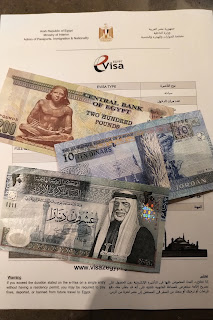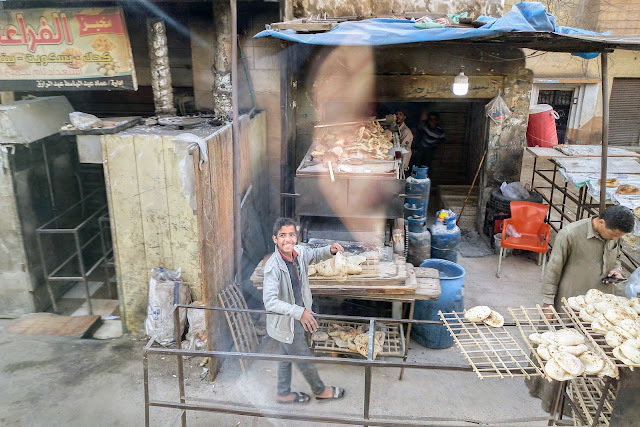Sorry, but no Hippos at the Hippodrome
After a sumptuous buffet breakfast where our 8 tour group members met, we joined our guide Salah for a long day visiting historical sites mostly outside Amman. Sammy, our driver, showed off his skills piloting the full sized bus through the Amman rush hour traffic. We stopped briefly at a Roman theatre, very well preserved, in the old part of Amman before driving to the town of Jerash, an ancient Greco-Roman Roman city which likely was home for about 65,000 at its peak.
The Gates of Hadrian - entrance to Jerash
The ruins of the city were discovered in 1806 and excavated since then. Probably only 40 percent (or perhaps less) has been uncovered. Much was preserved under rubble and sand which protected the structures. It is arguably as interesting a site as Ephesus. Now, having visited both, I would say that each has its own archeological value and each has some wonderfully revealing structures.
We spent several hours touring the site as Salah related the history and significance of various temples, rows of columns, the agora, the theatre, and so much more. The acoustics from a key spot on the floor in front of the theatre stage were incredible. Archeologists have even determined that the grooves in the paving stones on the main colonnaded road were made by the years of carts and chariots as they drove on the left side only and only in one direction.
One of the 3 entrances to the theatre stage.
A row of Corinthian columns on a Jerash paved road.
And, yes, we also visited the Jerash Hippodrome, the site of the Roman chariot races that could seat 15,000 spectators. Horses and humans - no hippos.
Intricate details on a column capital in the theatre.
Several hundred years ago, a massive earthquake shifted some of the columns out of line.
After our visit to Jerash, we stopped at a local restaurant for a traditional Jordanian meal with fresh baked flatbread from a wood oven, various dips and spreads, lamb, beef, and chicken kabobs, and salads.
Hummus at lunch
Next, we visited the Dead Sea, 412 metres below sea level. Most of the group waded in the highly salinated water, but one couple had their swim wear and went in for a float. We also saw people slathering themselves with Dead Sea mud and swimming in the water. In the haze, Israel was visible across the Sea.
We had an interesting conversation with Salah on the drive back to Amman discussing the population and economics of Jordan, its government, and the faith of Islam. Salah, who studied economics at university, is a Bedouin who spent the first years of his life with his nomadic family in the desert with their flocks and herds. His father wanted his son to be educated and pushed him in that direction, but Salah still goes back to the desert to live in his tent a couple months each year.
Tomorrow, we head to Petra and spend the night at a camp in Wadi Rum. Cool temperatures forecasted for our time in the Jordanian desert.
The Gates of Hadrian - entrance to Jerash
The ruins of the city were discovered in 1806 and excavated since then. Probably only 40 percent (or perhaps less) has been uncovered. Much was preserved under rubble and sand which protected the structures. It is arguably as interesting a site as Ephesus. Now, having visited both, I would say that each has its own archeological value and each has some wonderfully revealing structures.
We spent several hours touring the site as Salah related the history and significance of various temples, rows of columns, the agora, the theatre, and so much more. The acoustics from a key spot on the floor in front of the theatre stage were incredible. Archeologists have even determined that the grooves in the paving stones on the main colonnaded road were made by the years of carts and chariots as they drove on the left side only and only in one direction.
A row of Corinthian columns on a Jerash paved road.
And, yes, we also visited the Jerash Hippodrome, the site of the Roman chariot races that could seat 15,000 spectators. Horses and humans - no hippos.
Intricate details on a column capital in the theatre.
Several hundred years ago, a massive earthquake shifted some of the columns out of line.
After our visit to Jerash, we stopped at a local restaurant for a traditional Jordanian meal with fresh baked flatbread from a wood oven, various dips and spreads, lamb, beef, and chicken kabobs, and salads.
Hummus at lunch
Next, we visited the Dead Sea, 412 metres below sea level. Most of the group waded in the highly salinated water, but one couple had their swim wear and went in for a float. We also saw people slathering themselves with Dead Sea mud and swimming in the water. In the haze, Israel was visible across the Sea.
We had an interesting conversation with Salah on the drive back to Amman discussing the population and economics of Jordan, its government, and the faith of Islam. Salah, who studied economics at university, is a Bedouin who spent the first years of his life with his nomadic family in the desert with their flocks and herds. His father wanted his son to be educated and pushed him in that direction, but Salah still goes back to the desert to live in his tent a couple months each year.
Tomorrow, we head to Petra and spend the night at a camp in Wadi Rum. Cool temperatures forecasted for our time in the Jordanian desert.











Comments
Post a Comment